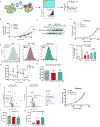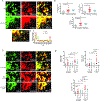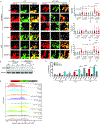Mitochondrial-derived vesicles compensate for loss of LC3-mediated mitophagy
- PMID: 34171288
- PMCID: PMC8319140
- DOI: 10.1016/j.devcel.2021.06.003
Mitochondrial-derived vesicles compensate for loss of LC3-mediated mitophagy
Abstract
Mitochondria are critical metabolic and signaling hubs, and dysregulated mitochondrial homeostasis is implicated in many diseases. Degradation of damaged mitochondria by selective GABARAP/LC3-dependent macro-autophagy (mitophagy) is critical for maintaining mitochondrial homeostasis. To identify alternate forms of mitochondrial quality control that functionally compensate if mitophagy is inactive, we selected for autophagy-dependent cancer cells that survived loss of LC3-dependent autophagosome formation caused by inactivation of ATG7 or RB1CC1/FIP200. We discovered rare surviving autophagy-deficient clones that adapted to maintain mitochondrial homeostasis after gene inactivation and identified two enhanced mechanisms affecting mitochondria including mitochondrial dynamics and mitochondrial-derived vesicles (MDVs). To further understand these mechanisms, we quantified MDVs via flow cytometry and confirmed an SNX9-mediated mechanism necessary for flux of MDVs to lysosomes. We show that the autophagy-dependent cells acquire unique dependencies on these processes, indicating that these alternate forms of mitochondrial homeostasis compensate for loss of autophagy to maintain mitochondrial health.
Keywords: ATG7; FIP200; SNX9; autophagy; cancer; late endosomes; mitochondria; mitochondrial dynamics; mitochondrial-derived vesicles; mitophagy.
Copyright © 2021 Elsevier Inc. All rights reserved.
Conflict of interest statement
Declaration of interests The authors declare no competing interests.
Figures






Comment in
-
MDVs to the rescue: How autophagy-deficient cancer cells adapt to defective mitophagy.Dev Cell. 2021 Jul 26;56(14):2010-2012. doi: 10.1016/j.devcel.2021.06.022. Dev Cell. 2021. PMID: 34314695
References
-
- CHEN H, CHOMYN A & CHAN DC 2005. Disruption of fusion results in mitochondrial heterogeneity and dysfunction. J Biol Chem, 280, 26185–92. - PubMed
Publication types
MeSH terms
Substances
Grants and funding
LinkOut - more resources
Full Text Sources
Research Materials

